|
History
The huge brick church of the Servites,
begun in the 13th century but enlarged over the next two centuries and so
not finished and consecrated until 1533. The 15th century façade remains
unfinished. Suffered harsh restoration in 1925.
Interior
The interior, remodelled during the Renaissance, is plain and fine,
though marred by 19th-century restoration. The majority of the art here is
very worthy of your attention and covers a wide range of centuries. There
are five deep bays with altars in each aisle.
Right side
The first on the right is a
small enclosed chapel with Anonymous 14th-century fresco fragments on the outside wall
of The Last Judgement (over the arch) and The Virgin Freeing
Souls from Purgatory (in a frame) (see far below right).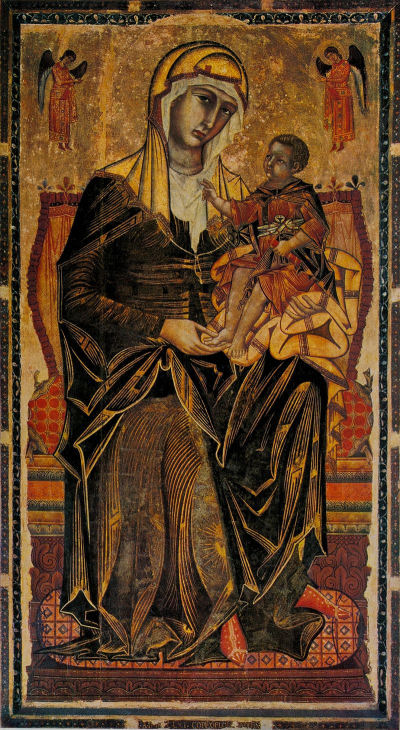
Over the
first main altar on the right is the very
Byzantine highlight Virgin and Child with
Two
Angels (known as the Madonna di Bordone because of a pilgrim's
staff previously placed near it) (see right) of 1261 by Coppo di Marcovaldo, a Florentine
artist captured at the battle of Montaperti in 1260 and probably made to paint this
picture to earn his freedom. It's his first known major work and the only
one safely attributable, having been signed and dated on the frame. The
painting is often cited by historians keen to stress the influenc of
Florentine art in Siena, but this denies the fact that Sienese artists
were having no trouble developing their own take on Byzantine art at the
time. The heads had their
detailing softened and made more Ducciesque by a local artist at the
beginning of the 14th century,
a fact revealed by x-radiography. It is flanked by Santa Caterina and
San Rocco panels by Arcangelo Salimbeni from the later 16th century.
The last altar on the right has an impressive and gilt-detailed
Massacre of the Innocents of 1491 by Matteo di Giovanni, who somewhat
specialised in altarpieces of this subject - two earlier versions are in
Santa Caterina a Formello in Naples and
Sant'Agostino here in Siena. He
also made a
marble pavement panel of the same subject in the Duomo. The one here features his perverse taste for
the stabby and
creepy. There is a Virgin and Saints lunette above by him too.
Transept
The end of the right
transept arm has a painted
14th century Crucifix, by Niccolò di
Segna. Underneath is an altar with the remains of the Blessed Francesco
Patrizi, a well-loved Sienese Servite of the 13th-century, known locally as Francesco Tarlato
(worm-eaten Francesco) due to the state of his remains. Over the door to the left is a small
Virgin and
Child by Segna di Bonaventura,
a nephew of Duccio and the father of the Niccolò mentioned above.
The 14th century Massacre of the Innocents
fresco on the right wall of the far right chapel in the deep transept is
by Niccolò and Francesco di Segna and Pietro Lorenzetti. The fresco of
Saint Agnes in the apse in here is school of Pietro Lorenzetti.
The chapel nearest the apse has an early 20th century gold-ground triptych by Alexander Franchi.
The high altarpiece is a big single panel depicting
The Coronation of the Virgin by Bernardino Fungai from 1501.
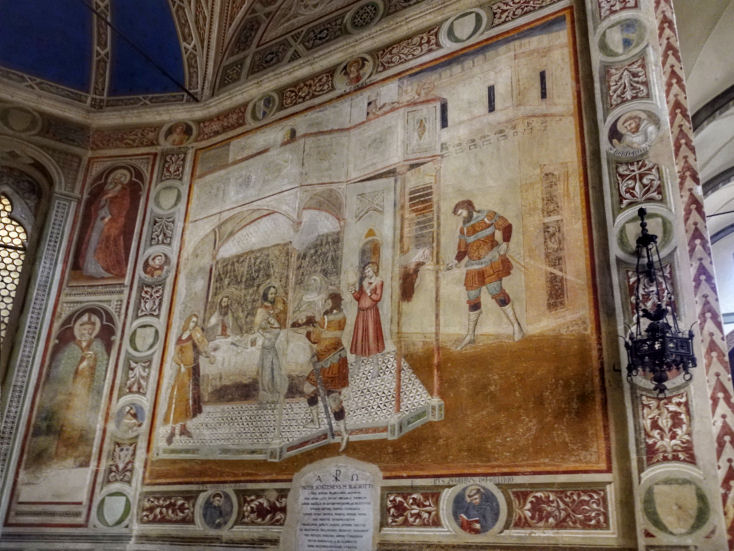
The first chapel left of
apse has some anonymous fresco fragments, but the last one has an impressive collection of big
damaged 14th-century frescoes by the same artists as the Massacre...
previously mentioned aka 'school of Pietro Lorenzetti'. They
depict the Banquet of Herod (see above) and Assumption of
John the Evangelist.
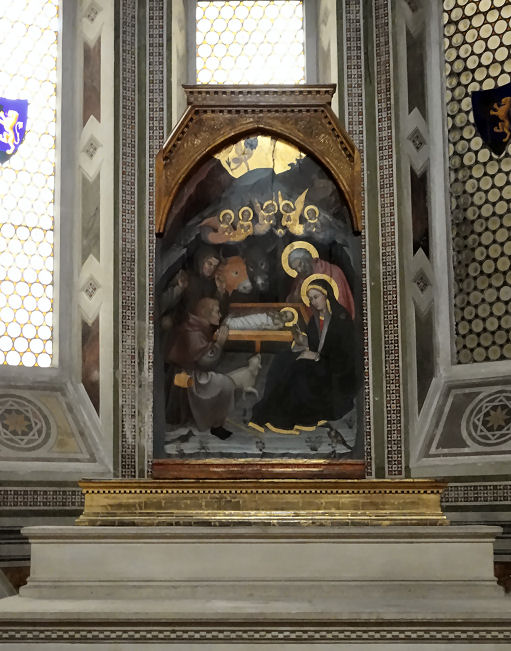 Also an Adoration of the Shepherds panel
of 1404 (see right) part
of a now disassembled triptych by Taddeo di Bartolo (see
Lost art below) which was painted
for the Bindi family altar. Also an Adoration of the Shepherds panel
of 1404 (see right) part
of a now disassembled triptych by Taddeo di Bartolo (see
Lost art below) which was painted
for the Bindi family altar.
Left side
The left transept end
chapel has a Madonna del Misericordia altarpiece, signed
and dated 1431 by Giovanni di Paolo,
a pupil of Taddeo di Bartolo. The leader of the
monks sheltered by the Virgin's cloak on one side is Filippo Benizzi, a
Servite general whose life is illustrated by Andrea del Sarto in the
Chiostrino dei Voti in
Santissima Annunziata in Florence.
Coming back up the left aisle,
second altar from the back has a small panel of the Madonna del Belvedere a rare work by Jacopo di Mino del Pelliciaio, a pupil of Lippo Memmi, flanked by
Saint Joseph and Mary Magdalene by Bernadino Fungai, also
responsible for the high altarpiece here. The first chapel has a bright
and Barocci-influenced
Annunciation by Francesco Vanni of 1589.
A Virgin and Child by Taddeo di Bartolo, called the Madonna
Belverde, of c.1405 was restored 2017-18, so maybe that's why I missed
it. It's called Belverde because in 1529 an outbreak of the plague lead to
the chapel where it was housed being draped in green cloth, in hope of the
Virgin's intercession. It was the central panel of an altarpiece painted
for the Petroni family for their chapel two along from the chancel in the
right transept, near the door to the sacristy. Next time (and the
similarly-titled Madonna in the previous paragraph worries me).
Lost art
A very sweet panel of the Virgin and Child Enthroned with Four Angels
of 1470 is all that remains of an altarpiece commissioned by the Della Ciaia
family for their altar here by Matteo
di Giovanni (see right) is in the Pinacoteca.
A Virgin and Child, known as the
Madonna del Popolo, signed by Lippo Memmi, (late 1320s) although its
high quality points to involvement by Simone Martini, his brother-in-law.
It is now in the
Pinacoteca.
The predella panel depicting The Adoration of the Magi flanked by
two Servite beati, from the lost 1404 triptych by Taddeo di Bartolo,
of which only the Adoration of the Shepherds panel mentioned above
remains here, is now in the Lindenau Museum in Altenburg. The panels
flanking the central ...Shepherds would have been full-length
saints, but are now lost.
Campanile
Massive, brick,
14th-century, restored in 1926.
Opening times
Daily 8.30 - 6.30
|
|

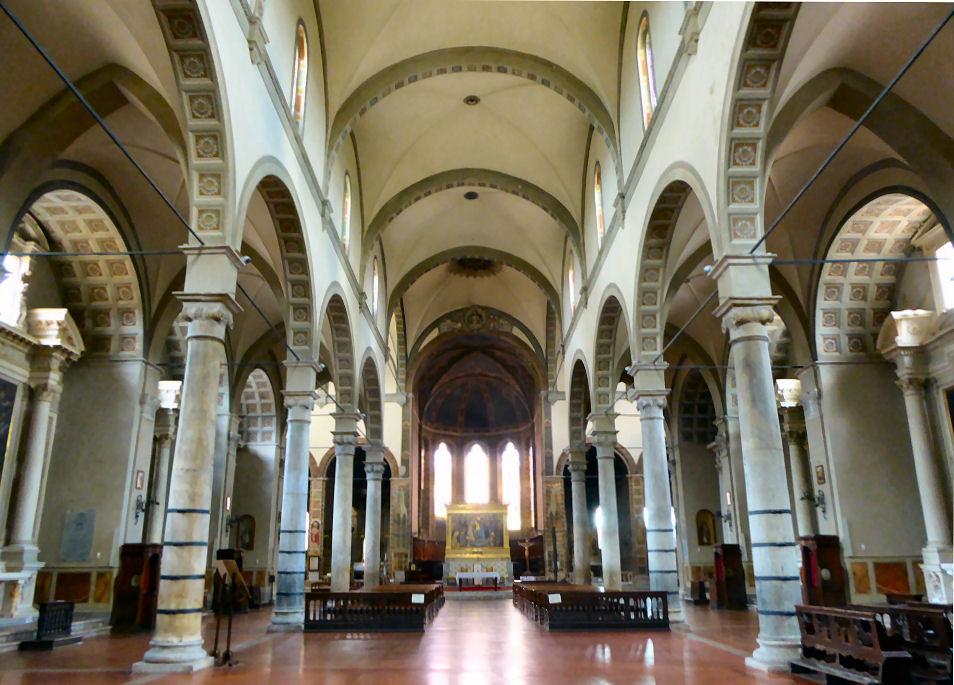

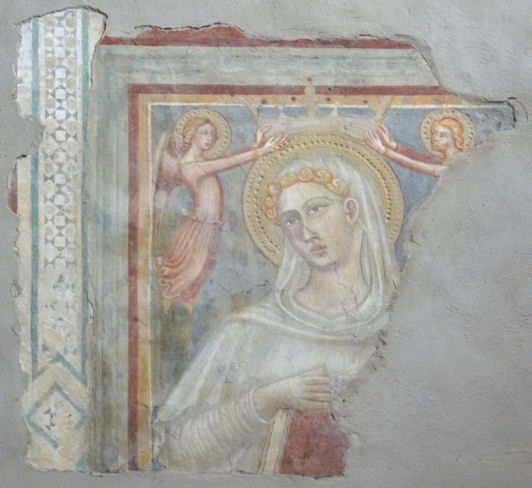
|